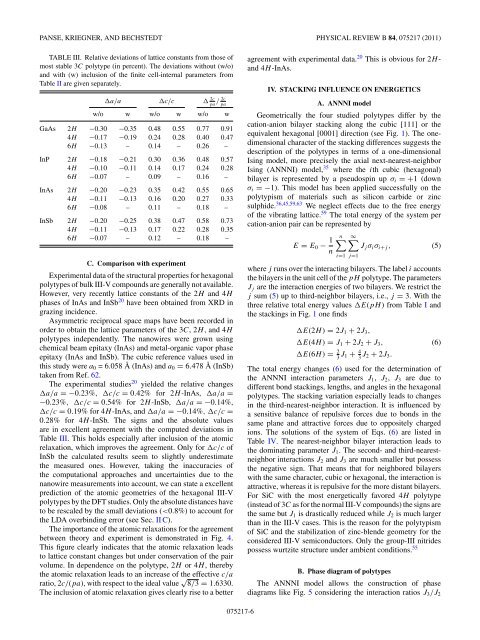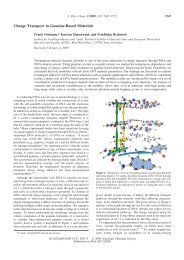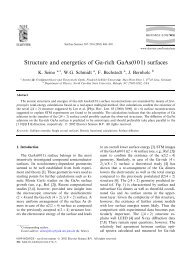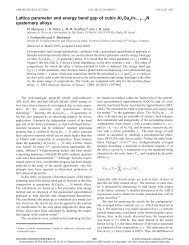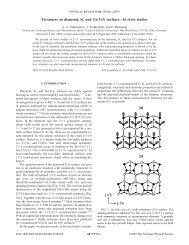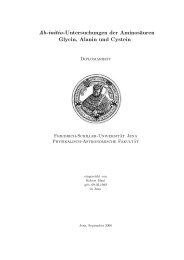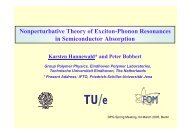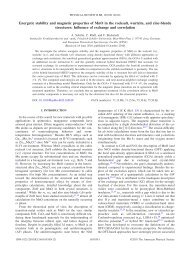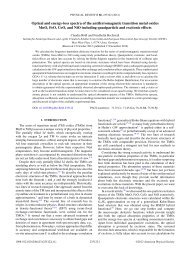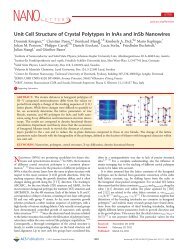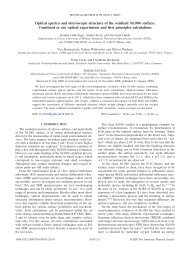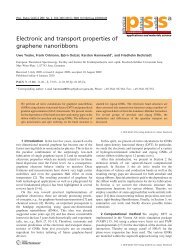Polytypism of GaAs, InP, InAs, and InSb: An ab initio study
Polytypism of GaAs, InP, InAs, and InSb: An ab initio study
Polytypism of GaAs, InP, InAs, and InSb: An ab initio study
Create successful ePaper yourself
Turn your PDF publications into a flip-book with our unique Google optimized e-Paper software.
PANSE, KRIEGNER, AND BECHSTEDT PHYSICAL REVIEW B 84, 075217 (2011)<br />
TABLE III. Relative deviations <strong>of</strong> lattice constants from those <strong>of</strong><br />
most st<strong>ab</strong>le 3C polytype (in percent). The deviations without (w/o)<br />
<strong>and</strong> with (w) inclusion <strong>of</strong> the finite cell-internal parameters from<br />
T<strong>ab</strong>le II are given separately.<br />
a/a c/c 2c<br />
pa / 2c<br />
pa<br />
w/o w w/o w w/o w<br />
<strong>GaAs</strong> 2H −0.30 −0.35 0.48 0.55 0.77 0.91<br />
4H −0.17 −0.19 0.24 0.28 0.40 0.47<br />
6H −0.13 – 0.14 – 0.26 –<br />
<strong>InP</strong> 2H −0.18 −0.21 0.30 0.36 0.48 0.57<br />
4H −0.10 −0.11 0.14 0.17 0.24 0.28<br />
6H −0.07 – 0.09 – 0.16 –<br />
<strong>InAs</strong> 2H −0.20 −0.23 0.35 0.42 0.55 0.65<br />
4H −0.11 −0.13 0.16 0.20 0.27 0.33<br />
6H −0.08 – 0.11 – 0.18 –<br />
<strong>InSb</strong> 2H −0.20 −0.25 0.38 0.47 0.58 0.73<br />
4H −0.11 −0.13 0.17 0.22 0.28 0.35<br />
6H −0.07 – 0.12 – 0.18 –<br />
C. Comparison with experiment<br />
Experimental data <strong>of</strong> the structural properties for hexagonal<br />
polytypes <strong>of</strong> bulk III-V compounds are generally not avail<strong>ab</strong>le.<br />
However, very recently lattice constants <strong>of</strong> the 2H <strong>and</strong> 4H<br />
phases <strong>of</strong> <strong>InAs</strong> <strong>and</strong> <strong>InSb</strong> 20 have been obtained from XRD in<br />
grazing incidence.<br />
Asymmetric reciprocal space maps have been recorded in<br />
order to obtain the lattice parameters <strong>of</strong> the 3C, 2H , <strong>and</strong> 4H<br />
polytypes independently. The nanowires were grown using<br />
chemical beam epitaxy (<strong>InAs</strong>) <strong>and</strong> metal-organic vapor phase<br />
epitaxy (<strong>InAs</strong> <strong>and</strong> <strong>InSb</strong>). The cubic reference values used in<br />
this <strong>study</strong> were a 0 = 6.058 Å (<strong>InAs</strong>) <strong>and</strong> a 0 = 6.478 Å (<strong>InSb</strong>)<br />
taken from Ref. 62.<br />
The experimental studies 20 yielded the relative changes<br />
a/a =−0.23%, c/c = 0.42% for 2H -<strong>InAs</strong>, a/a =<br />
−0.23%, c/c = 0.54% for 2H -<strong>InSb</strong>, a/a =−0.14%,<br />
c/c = 0.19% for 4H -<strong>InAs</strong>, <strong>and</strong> a/a =−0.14%,c/c=<br />
0.28% for 4H -<strong>InSb</strong>. The signs <strong>and</strong> the <strong>ab</strong>solute values<br />
are in excellent agreement with the computed deviations in<br />
T<strong>ab</strong>le III. This holds especially after inclusion <strong>of</strong> the atomic<br />
relaxation, which improves the agreement. Only for c/c <strong>of</strong><br />
<strong>InSb</strong> the calculated results seem to slightly underestimate<br />
the measured ones. However, taking the inaccuracies <strong>of</strong><br />
the computational approaches <strong>and</strong> uncertainties due to the<br />
nanowire measurements into account, we can state a excellent<br />
prediction <strong>of</strong> the atomic geometries <strong>of</strong> the hexagonal III-V<br />
polytypes by the DFT studies. Only the <strong>ab</strong>solute distances have<br />
to be rescaled by the small deviations (


